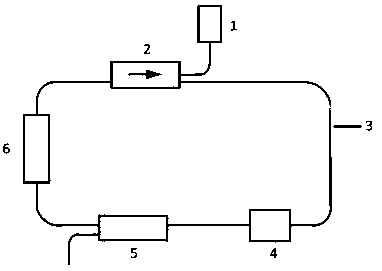A dissipative soliton laser at 2 micron wavelength band
A technology of dissipating solitons and lasers, which is applied in the direction of lasers, phonon exciters, laser components, etc., can solve the problems of not giving spectra, etc., and achieve the effect of low insertion loss and simple structure
- Summary
- Abstract
- Description
- Claims
- Application Information
AI Technical Summary
Problems solved by technology
Method used
Image
Examples
Embodiment 1
[0029] In this embodiment, the structure of the dissipative soliton laser is as figure 1 shown. The diameter of the waist section of the micro-nano fiber is 1 micron, the length L1 of the waist section is 10 cm, the central wavelength of the spectral filter is 1925 nm, and the bandwidth is 45 nm; , the optical fiber polarization beam splitter 5 and the micro-nano fiber 6 are connected in series to form the loop of the laser resonator, except the waist section of the micro-nano fiber, the tapered transition zone of the micro-nano fiber, the tail fiber of the micro-nano fiber, the gain fiber 3 and The sum L-L1 of the pigtail lengths of all devices is 3.85 m, that is, L1:(L-L1) is 1:38.5.
[0030] The activation of the mode-locked state of the dissipative soliton laser is achieved by setting the state of the fiber polarization controller 4 and the power of the pump light 1 . From figure 2 It can be seen that after the optimized combination of the parameters of the micro-nano ...
Embodiment 2
[0032] In this embodiment, the structure of the dissipative soliton laser is as figure 1 shown. Among them, the length L1 of the waist section of the micro-nano fiber is 5 mm, and the diameter of the waist section is 800 nm. In the loop of the laser resonator composed of the hybrid device 2, the gain fiber 3, the fiber polarization controller 4, the fiber polarization beam splitter 5 and the micro-nano fiber 6 in series, except for the waist section 7 of the micro-nano fiber, the micro-nano fiber The sum L-L1 of the lengths of the tapered transition zone 9, the pigtail 8 of the micro-nano fiber, the gain fiber 3 and all the device pigtails is 0.25 m, that is, L1:(L-L1) is 1:50. The spectral filter has a center wavelength of 1750 nm and a bandwidth of 10 nm. Depend on image 3 It can be seen that the 3 dB bandwidth of the output spectrum of the laser in this embodiment is about 13 nm, and it is very flat.
Embodiment 3
[0034]In this embodiment, the structure of the dissipative soliton laser is as figure 1 shown. Among them, the waist length L1 of the micro-nano fiber is 1 m and the diameter is 1600 nm. In the loop of the laser resonator composed of the hybrid device 2, the gain fiber 3, the fiber polarization controller 4, the fiber polarization beam splitter 5 and the micro-nano fiber 6 in series, except for the waist section 7 of the micro-nano fiber, the micro-nano fiber The sum L-L1 of the lengths of the tapered transition zone 9, the pigtail 8 of the micro-nano fiber, the gain fiber 3 and all the device pigtails is 3.9 m, that is, L1:(L-L1) is 1:3.9. The spectral filter has a center wavelength of 2200 nm and a bandwidth of 60 nm. Depend on Figure 4 It can be seen that the output spectrum of the laser in this embodiment is relatively broad, 60 nm, and the spectrum is flat.
PUM
| Property | Measurement | Unit |
|---|---|---|
| Diameter | aaaaa | aaaaa |
| Center wavelength | aaaaa | aaaaa |
| Bandwidth | aaaaa | aaaaa |
Abstract
Description
Claims
Application Information
 Login to View More
Login to View More - R&D
- Intellectual Property
- Life Sciences
- Materials
- Tech Scout
- Unparalleled Data Quality
- Higher Quality Content
- 60% Fewer Hallucinations
Browse by: Latest US Patents, China's latest patents, Technical Efficacy Thesaurus, Application Domain, Technology Topic, Popular Technical Reports.
© 2025 PatSnap. All rights reserved.Legal|Privacy policy|Modern Slavery Act Transparency Statement|Sitemap|About US| Contact US: help@patsnap.com



